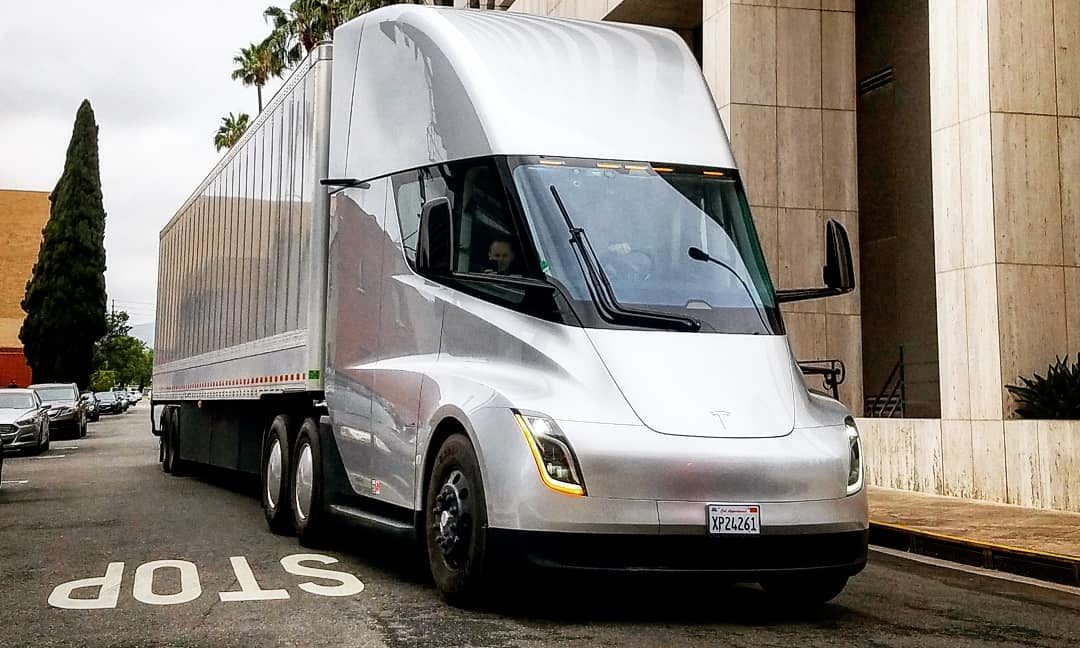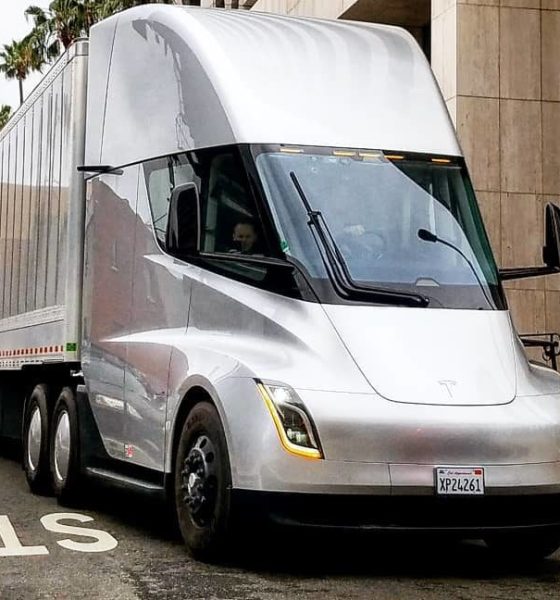

News
Tesla Semi, all-electric trucks get scathing criticism from auto tech expert
The Tesla Semi might be receiving a lot of interest from companies and the electric vehicle community as a whole, but an automotive technology expert from Germany is not that impressed. In a statement, Chair of Automotive Engineering at the Technical University of Munich Markus Lienkamp criticized all-electric trucks like the Tesla Semi, stating that such vehicles are pretty much pointless in the economic and ecological sense.
“The battery for a Tesla Semi must have a capacity of about 1000 kWh, per 100 kilometers about 130 kilowatt-hours. This is technically not easily feasible and it’s also pointless both economically and ecologically,” he said.
Lienkamp’s scathing criticism comes on the heels of a study from Transport and Environment, a consortium of European environmental organizations that conducted a study comparing the energy consumption and environmental costs of conventional diesel trucks and their all-electric counterparts. Two diesel trucks were used for the study: one with an average consumption of 33 liters per 100 kilometers (around 7 mpg) and a more aerodynamic truck with a consumption of 22 liters per 100 km (10.69 mpg).
The results of Transport and Environment’s study found that diesel trucks consume between 2.2-3.3 kilowatt-hours per kilometer, far above the consumption of an average electric truck, which requires 1.44 kWh per km. Electric vehicles that are designed from the ground up for maximum efficiency such as the Tesla Semi require just 1.15 kWh per km. The study’s authors concluded that overall, using all-electric trucks reduces energy consumption by a factor of 1.5-2.9.
All-electric trucks surpass diesel trucks in terms of efficiency as well. The study revealed that a diesel truck engine has an efficiency of 20-45% on long-haul routes and a measly 10% in city traffic. In comparison, electric trucks have a 90% efficiency for long routes and 75% in urban traffic. Lienkamp is not convinced, arguing that the source of the electricity used by vehicles like the Tesla Semi affects efficiency.
“The efficiency of the electricity mix used for the truck battery is important. If the energy comes from a gas-fired power plant, for example, the overall efficiency quickly drops back to 40%. If, on the other hand, 80% to 90% of the electricity comes from renewable sources, as planned in the EU for 2040, long-distance trucks would be attractive from an ecological point of view,” he said.

The authors of the study maintained that electric trucks are cheaper to repair and maintain simply because they have fewer moving parts. Even brakes will rarely need replacing, thanks to systems like regenerative braking. While these are compelling advantages, Lienkamp stated that “for distances of 500 kilometers and beyond, battery-powered trucks simply won’t make any economic sense until 2030,” adding “with electric vehicles, the cost of trying to reduce CO2 levels is simply too high.”
It should be noted that the Tesla Semi, at least in its upcoming iteration, is not designed to enter the long-haul market that is dominated by trucks that can go over 1,000 miles in one full tank. Rather, the Tesla Semi is designed to compete in short-range routes that range from 300-500 miles. From this perspective, it becomes difficult to argue against the Tesla Semi.
The Tesla Semi is a Class 8 truck, and with its four Model 3-derived electric motors, the all-electric long-hauler is capable of sprinting from 0-60 mph in just 5 seconds without a trailer. With a full load, the Semi can reach highway speeds in 20 seconds, far quicker than conventional diesel trucks. The Tesla Semi is currently undergoing real-world tests, in preparation for its production, which is expected to start either this year or sometime in 2020.

Elon Musk
Elon Musk’s X will start using a Tesla-like software update strategy
The initiative seems designed to accelerate updates to the social media platform, while maintaining maximum transparency.

Elon Musk’s social media platform X will adopt a Tesla-esque approach to software updates for its algorithm.
The initiative seems designed to accelerate updates to the social media platform, while maintaining maximum transparency.
X’s updates to its updates
As per Musk in a post on X, the social media company will be making a new algorithm to determine what organic and advertising posts are recommended to users. These updates would then be repeated every four weeks.
“We will make the new 𝕏 algorithm, including all code used to determine what organic and advertising posts are recommended to users, open source in 7 days. This will be repeated every 4 weeks, with comprehensive developer notes, to help you understand what changed,” Musk wrote in his post.
The initiative somewhat mirrors Tesla’s over-the-air update model, where vehicle software is regularly refined and pushed to users with detailed release notes. This should allow users to better understand the details of X’s every update and foster a healthy feedback loop for the social media platform.
xAI and X
X, formerly Twitter, has been acquired by Elon Musk’s artificial intelligence startup, xAI last year. Since then, xAI has seen a rapid rise in valuation. Following the company’s the company’s upsized $20 billion Series E funding round, estimates now suggest that xAI is worth tens about $230 to $235 billion. That’s several times larger than Tesla when Elon Musk received his controversial 2018 CEO Performance Award.
As per xAI, the Series E funding round attracted a diverse group of investors, including Valor Equity Partners, Stepstone Group, Fidelity Management & Research Company, Qatar Investment Authority, MGX, and Baron Capital Group, among others. Strategic partners NVIDIA and Cisco Investments also continued support for building the world’s largest GPU clusters.
News
Tesla FSD Supervised wins MotorTrend’s Best Driver Assistance Award
The decision marks a notable reversal for the publication from prior years, with judges citing major real-world improvements that pushed Tesla’s latest FSD software ahead of every competing ADAS system.

Tesla’s Full Self-Driving (Supervised) system has been named the best driver-assistance technology on the market, earning top honors at the 2026 MotorTrend Best Tech Awards.
The decision marks a notable reversal for the publication from prior years, with judges citing major real-world improvements that pushed Tesla’s latest FSD software ahead of every competing ADAS system. And it wasn’t even close.
MotorTrend reverses course
MotorTrend awarded Tesla FSD (Supervised) its 2026 Best Tech Driver Assistance title after extensive testing of the latest v14 software. The publication acknowledged that it had previously criticized earlier versions of FSD for erratic behavior and near-miss incidents, ultimately favoring rivals such as GM’s Super Cruise in earlier evaluations.
According to MotorTrend, the newest iteration of FSD resolved many of those shortcomings. Testers said v14 showed far smoother behavior in complex urban scenarios, including unprotected left turns, traffic circles, emergency vehicles, and dense city streets. While the system still requires constant driver supervision, judges concluded that no other advanced driver-assistance system currently matches its breadth of capability.
Unlike rival systems that rely on combinations of cameras, radar, lidar, and mapped highways, Tesla’s FSD operates using a camera-only approach and is capable of driving on city streets, rural roads, and freeways. MotorTrend stated that pure utility, the ability to handle nearly all road types, ultimately separated FSD from competitors like Ford BlueCruise, GM Super Cruise, and BMW’s Highway Assistant.
High cost and high capability
MotorTrend also addressed FSD’s pricing, which remains significantly higher than rival systems. Tesla currently charges $8,000 for a one-time purchase or $99 per month for a subscription, compared with far lower upfront and subscription costs from other automakers. The publication noted that the premium is justified given FSD’s unmatched scope and continuous software evolution.
Safety remained a central focus of the evaluation. While testers reported collision-free operation over thousands of miles, they noted ongoing concerns around FSD’s configurable driving modes, including options that allow aggressive driving and speeds beyond posted limits. MotorTrend emphasized that, like all Level 2 systems, FSD still depends on a fully attentive human driver at all times.
Despite those caveats, the publication concluded that Tesla’s rapid software progress fundamentally reshaped the competitive landscape. For drivers seeking the most capable hands-on driver-assistance system available today, MotorTrend concluded Tesla FSD (Supervised) now stands alone at the top.
News
Elon Musk’s Grokipedia surges to 5.6M articles, almost 79% of English Wikipedia
The explosive growth marks a major milestone for the AI-powered online encyclopedia, which was launched by Elon Musk’s xAI just months ago.

Elon Musk’s Grokipedia has grown to an impressive 5,615,201 articles as of today, closing in on 79% of the English Wikipedia’s current total of 7,119,376 articles.
The explosive growth marks a major milestone for the AI-powered online encyclopedia, which was launched by Elon Musk’s xAI just months ago. Needless to say, it would only be a matter of time before Grokipedia exceeds English Wikipedia in sheer volume.
Grokipedia’s rapid growth
xAI’s vision for Grokipedia emphasizes neutrality, while Grok’s reasoning capabilities allow for fast drafting and fact-checking. When Elon Musk announced the initiative in late September 2025, he noted that Grokipedia would be an improvement to Wikipedia because it would be designed to avoid bias.
At the time, Musk noted that Grokipedia “is a necessary step towards the xAI goal of understanding the Universe.”
Grokipedia was launched in late October, and while xAI was careful to list it only as Version 0.1 at the time, the online encyclopedia immediately earned praise. Wikipedia co-founder Larry Sanger highlighted the project’s innovative approach, noting how it leverages AI to fill knowledge gaps and enable rapid updates. Netizens also observed how Grokipedia tends to present articles in a more objective manner compared to Wikipedia, which is edited by humans.
Elon Musk’s ambitious plans
With 5,615,201 total articles, Grokipedia has now grown to almost 79% of English Wikipedia’s article base. This is incredibly quick, though Grokipedia remains text-only for now. xAI, for its part, has now updated the online encyclopedia’s iteration to v0.2.
Elon Musk has shared bold ideas for Grokipedia, including sending a record of the entire knowledge base to space as part of xAI’s mission to preserve and expand human understanding. At some point, Musk stated that Grokipedia will be renamed to Encyclopedia Galactica, and it will be sent to the cosmos.
“When Grokipedia is good enough (long way to go), we will change the name to Encyclopedia Galactica. It will be an open source distillation of all knowledge, including audio, images and video. Join xAI to help build the sci-fi version of the Library of Alexandria!” Musk wrote, adding in a later post that “Copies will be etched in stone and sent to the Moon, Mars and beyond. This time, it will not be lost.”








